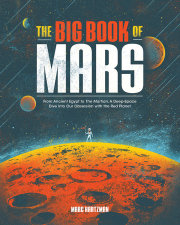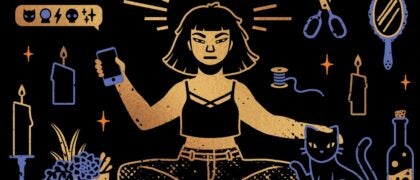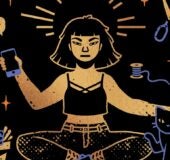A Message From This Side of the Veil
My first encounter with death happened at the age of ten when my grandmother passed away. In Judaism, bodies are buried within a few days and always in a simple pine box. Wealth, if achieved, does not follow one into the grave. I attended the funeral and listened to the prayers, wept alongside family, and watched the coffin get lowered into the ground. Generally speaking, it was the type of ceremony that’s done in all parts of the world—and has been for thousands of years. So it must be the correct way to do things, right? Yet since that day I’ve wondered, what if it’s not? Could humankind have been wrong all this time, leaving countless generations of spirits trapped and suffocating six feet underground?
There’s no proven way to know. Not unless, of course, you believe in ghosts. Belief in spirits and in the reasons they appear and disappear vary over time and in different cultures, but those beliefs have always existed. When I started writing this book, I claimed to have never seen a ghost—and firmly believed that was true. But in speaking with parapsychologists, paranormal investigators, ghost tour guides, Spiritualists, a modern-day psychopomp, cultural historians, a professor at the Rhine Education Center, and employees of haunted inns and taverns, I’m not so sure that I’ve never seen a ghost. Part of it certainly comes down to personal views but it also depends on one’s definition of “seeing a ghost.” We have a tendency to think that ghosts, apparitions, spirits, specters, and wraiths just appear in front us, like in the movies. A translucent thing that floats through dark, creepy hallways and cellars. But what if the deceased are projecting themselves into our minds while we're awake and dreaming? What if we’re seeing ghosts a lot more often than we think and we just can’t acknowledge it?
These are just questions swirling in my mind, though other individuals are clearer on these points. For example, the hamlet of Lily Dale Assembly in New York, a small community just outside of Buffalo, has been home to mediums and Spiritualists since the late nineteenth century. Signs reading medium hang outside a majority of the homes. Posted inside the church are the Principles of Spiritualism, which include the tenets “We never die” and “Spiritualism proves that we can talk with people in the spirit world.” The nature of death and the existence of an afterlife aren’t mysteries; they’re truths. Quite appealing truths, considering how this view of death can offer such peace in life.
Twice a day visitors are invited to experience these beliefs at Inspiration Stump—an actual tree stump standing about three feet high with a roughly four-foot diameter that’s situated in a quiet corner of Leolyn Woods (not far from a pet cemetery). After the tree was struck by lightning in the late 1800s, it was leveled off and filled with concrete. Steps were added, allowing people to ascend to its top and feel the vortex of spiritual energy that has built up from the many mediums who’ve gathered there over the past century. Rows of wooden benches facing the stump fill with people ready to receive a reading from one of the local registered mediums, visiting mediums, or student mediums. For about an hour, these psychics take turns delivering messages as they come from Spirit.
The people of Lily Dale aren’t the only ones who believe in ghosts. According to a 2019 survey by the data website YouGov, forty-five percent of Americans believe in ghosts. As I was writing this book, I learned some of them are my friends and coworkers. One of them—let’s call her Rebecca—has had many paranormal experiences and always gets a welcome or unwelcome feeling while house-hunting. “The hair stands on the back of my neck,” my friend told me. “It’s my bar for getting a new home.” At her most recent address in New York, she felt nothing and determined the house was “a total blank slate.” That is, until Rebecca,s three-year-old daughter asked her about “the worker guy that comes here at night” who stands at the foot of her bed and “looks at me.” Rebecca gave her daughter some sage advice: “Just tell him to go away. He’s not welcome.”
Another friend—let’s call him Phillip—told me about the time he was in college and wanted to grab some munchies from his fraternity house pantry after a late night. The only problem was the pantry was in a nineteenth-century fieldstone cellar, accessed by a “creepy corridor” and a concrete stairwell. “No one liked going down to the pantry alone at night,” Phillip said. “There’s nothing more pathetic then a twenty-year-old man in the prime of his life afraid of the dark. Which is why I was incredibly relieved when I entered the cellar corridor to hear a few of the guys shuffling around and laughing. I couldn’t make out exactly what was being said, but I was happy as hell to have them there.”
He headed toward the voices to say hello, but no one was there. The basement was completely empty. “I immediately bolted up the stairwell back to the first floor, where I hoped to see people directly above where the pantry was located,” Phillip explained. “At least that would provide a logical explanation for what happened—but no one was there.” A few years later, at an alumni event, Phillip began telling the story and someone else finished it for him, sharing the exact same experience in the same basement.
James, a pharmacist I met in the small town of Smithfield, Pennsylvania, also had stories. Ghosts weren’t known to hang around the Advil or antibiotics at his pharmacy, but they did congregate at a diner he previously owned down the street. Knives would fly off the counter, the strings on waitresses’ aprons would get pulled from behind, and once a doorbell kept ringing despite the fact that the building didn’t have one.
“The most vivid experience I had was on a holiday. We had closed early,” James explained. “I went to close the register at, like, one thirty in the afternoon. I was doing the register, and there was a lady in white. I mean, the chills, oh my God! Ghostly looking. I just got so many chills. Middle of the afternoon! She was coming right through the archway into the kitchen. Most of the activity took place in that area. I still get chills thinking about it. It was so real.”
These are just ordinary people who’ve experienced something extraordinary. Given the YouGov survey, I have to think there are millions of stories like these. It’s no wonder so many television shows have tapped into the paranormal. It seems there are enough ghosts to feed dozens of programs for multiple seasons. While some are purely escapist entertainment, others strive to balance enjoyment with the presentation of information. When I spoke with the executive producer of
Ghost Adventures, Michael Yudin, he was quick to stress the importance of that balance.
“We do the history, we do interviews with people, then [the team will] stay [at the haunted site] for forty-eight hours by themselves overnight and film. We cover the whole thing. And we call out what’s bullshit if we don’t think it’s real. We’re just trying to represent what we see as the fact. You make your own decisions.”
After more than two hundred episodes filmed at allegedly haunted locations across America and witnessing the evidence that the show’s host, Zak Bagans, and his crew have produced, Yudin is convinced something is going on. “I have definitely gone from not believing in ghosts to unquestionably believing in the unexplained,” he says.
In this book, we’ll go on a journey to explore the different relationships the living have had with the dead, from ancient myths to the beliefs of the Victorian Spiritualists to the ghost stories that have shaped our modern conception of the supernatural world. We’ll also explore the human effort to capture evidence of the spirit world throughout the ages using period-specific technology. We’ll visit famous haunted sites and investigate possible explanations for various paranormal events, from parapsychological to more traditional scientific views. By the end, it will be up to you to decide if the theories presented confirm your beliefs one way or the other—or leave you pondering the possibilities of what might await us all.
Copyright © 2021 by Marc Hartzman. All rights reserved. No part of this excerpt may be reproduced or reprinted without permission in writing from the publisher.










